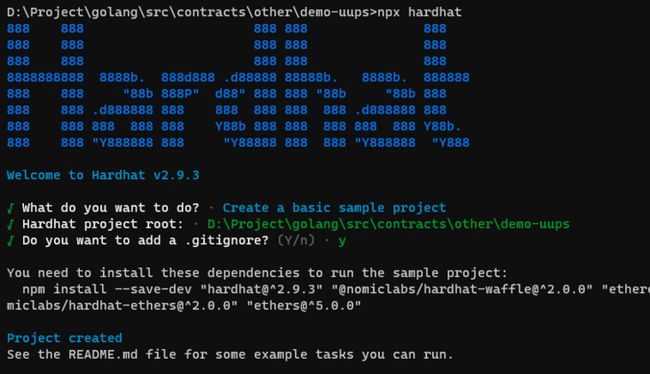id:BSN_2021
公众号:BSN研习社
背景:在开发或维护solidity语言的智能合约时,经常会因为业务逻辑变动而变动合约内的逻辑,这就要考虑在不影响以前智能合约中已上链的数据的同时,修改或扩展新的业务逻辑,所以合约第一次开发时就需要考虑其本身支持可升级功能
目的:本篇文章是为了让读者快速上手使用hardhat并搭配openZeppelin的uups升级模式对合约进行可升级适配以及指导后续如何进行合约升级
适用对象:适用于BSN开放联盟链武汉链(基于ETH),也可适用于其他支持solidity语言的链框架
如何使用hardhat进行合约uups模式升级
- 安装hardhat
- 初始化项目
- 编写合约
- 编写测试文件
- 编辑配置文件
- 执行项目
- 参考
安装hardhat
1.创建空的文件夹demo-uups并进入文件夹里面,执行npm init
2.执行安装命令npm install --save-dev hardhat
3.安装依赖npm install --save-dev @nomiclabs/hardhat-waffle ethereum-waffle chai @nomiclabs/hardhat-ethers ethers
4.安装openZeppelin的uups可升级合约包 npm install --save-dev @openzeppelin/contracts-upgradeable
5.安装测试工具mocha npm install --save-dev mocha
初始化项目
执行npx hardhat选择Create a basic sample project
初始化完成后的目录结构为
编写合约
在contracts目录下面新建两个名称分别为MyLogicV1和MyLogicV2的.sol文件并进行代码编写。实现openZeppelin的uups升级模式必须要引入openZeppelin相关库文件,且必须在constructor()方法上加@custom:oz-upgrades-unsafe-allow constructor字样注释
// contract/MyLogicV1.sol
// SPDX-License-Identifier: MIT
pragma solidity ^0.8.0;
import "@openzeppelin/contracts-upgradeable/proxy/utils/Initializable.sol";
import "@openzeppelin/contracts-upgradeable/proxy/utils/UUPSUpgradeable.sol";
import "@openzeppelin/contracts-upgradeable/access/OwnableUpgradeable.sol";
contract MyLogicV1 is Initializable, UUPSUpgradeable, OwnableUpgradeable {
function initialize() initializer public {
__Ownable_init();
__UUPSUpgradeable_init();
}
/// @custom:oz-upgrades-unsafe-allow constructor
constructor() initializer {}
function _authorizeUpgrade(address) internal override onlyOwner {}
mapping(string => uint256) private logic;
event logicSetted(string indexed _key, uint256 _value);
function SetLogic(string memory _key, uint256 _value) external {
logic[_key] = _value;
emit logicSetted(_key, _value);
}
function GetLogic(string memory _key) public view returns (uint256){
return logic[_key];
}
}
// contract/MyLogicV2.sol
// SPDX-License-Identifier: MIT
pragma solidity ^0.8.0;
import "@openzeppelin/contracts-upgradeable/proxy/utils/Initializable.sol";
import "@openzeppelin/contracts-upgradeable/proxy/utils/UUPSUpgradeable.sol";
import "@openzeppelin/contracts-upgradeable/access/OwnableUpgradeable.sol";
contract MyLogicV2 is Initializable, UUPSUpgradeable, OwnableUpgradeable {
function initialize() initializer public {
__Ownable_init();
__UUPSUpgradeable_init();
}
/// @custom:oz-upgrades-unsafe-allow constructor
constructor() initializer {}
function _authorizeUpgrade(address) internal override onlyOwner {}
mapping(string => uint256) private logic;
event logicSetted(string indexed _key, uint256 _value);
function SetLogic(string memory _key, uint256 _value) external {
logic[_key] = _value;
emit logicSetted(_key, _value);
}
function GetLogic(string memory _key) public view returns (uint256){
return logic[_key]+100;
}
}MyLogicV1实现了一个对于logic的map的写入方法和读取方法,MyLogicV2只是改写了MyLogicV1的GetLogic方法中的处理逻辑,使得每次返回的值加了100
编写测试文件
在test目录下创建生成名称为update-test的.js文件并进行代码编写
// test/update-test.ts
const { expect } = require('chai');
const { ethers, upgrades } = require('hardhat');
let myLogicV1;
let myLogicV2;
describe('uups mode upgrade', function () {
it('deploys', async function () {
const MyLogicV1 = await ethers.getContractFactory('MyLogicV1');
myLogicV1 = (await upgrades.deployProxy(MyLogicV1, {kind: 'uups'}));
console.log(myLogicV1.address);
})
it('myLogicV1 set', async function () {
await myLogicV1.SetLogic("aa", 1);
expect((await myLogicV1.GetLogic("aa")).toString()).to.equal('1');
})
it('upgrades', async function () {
const MyLogicV2 = await ethers.getContractFactory('MyLogicV2');
myLogicV2 = (await upgrades.upgradeProxy(myLogicV1, MyLogicV2));
console.log(myLogicV2.address);
})
it('myLogicV2 get', async function () {
expect((await myLogicV2.GetLogic("aa")).toString()).to.equal('101');
})
})测试文件步骤详解
- deploys: 调用upgrades中的deployProxy方法以uups的方式部署MyLogicV1合约
- myLogicV1 set:调用MyLogicV1合约中的SetLogic方法将值传入,并调用GetLogic方法确认返回值为1
- upgrades:调用upgrades中的upgradeProxy方法升级
- myLogicV2 get:调用MyLogicV2合约中的GetLogic方法确认返回值为101
编辑配置文件
编辑hardhat.config.js文件
require("@nomiclabs/hardhat-waffle");
require('@openzeppelin/hardhat-upgrades');
// This is a sample Hardhat task. To learn how to create your own go to
// https://hardhat.org/guides/create-task.html
task("accounts", "Prints the list of accounts", async (taskArgs, hre) => {
const accounts = await hre.ethers.getSigners();
for (const account of accounts) {
console.log(account.address);
}
});
// You need to export an object to set up your config
// Go to https://hardhat.org/config/ to learn more
/**
* @type import('hardhat/config').HardhatUserConfig
*/
module.exports = {
solidity: {
version: "0.8.4",
settings: {
optimizer: {
enabled: true,
runs: 200
}
}
},
mocha: { timeout: 60000 }
};
执行项目
1.执行编译合约
npx hardhat compile
2.启动本地测试节点
npx hardhat node
3.新开一个窗口运行测试文件
npx hardhat test test/update-test.js --network localhost
测试通过,合约地址都为代理合约地址,测试说明成功升级改写了GetLogic中的处理逻辑,使得每次返回的值都在原来的基础上多加了100
参考
Hardhat官方文档:Overview | Hardhat | Ethereum development environment for professionals by Nomic Foundation[1]
OpenZeppelin官方文档:Using with Upgrades - OpenZeppelin Docs[2]
References
[1] Overview | Hardhat | Ethereum development environment for professionals by Nomic Foundation: https://hardhat.org/getting-s...
[2] Using with Upgrades - OpenZeppelin Docs: https://docs.openzeppelin.com...